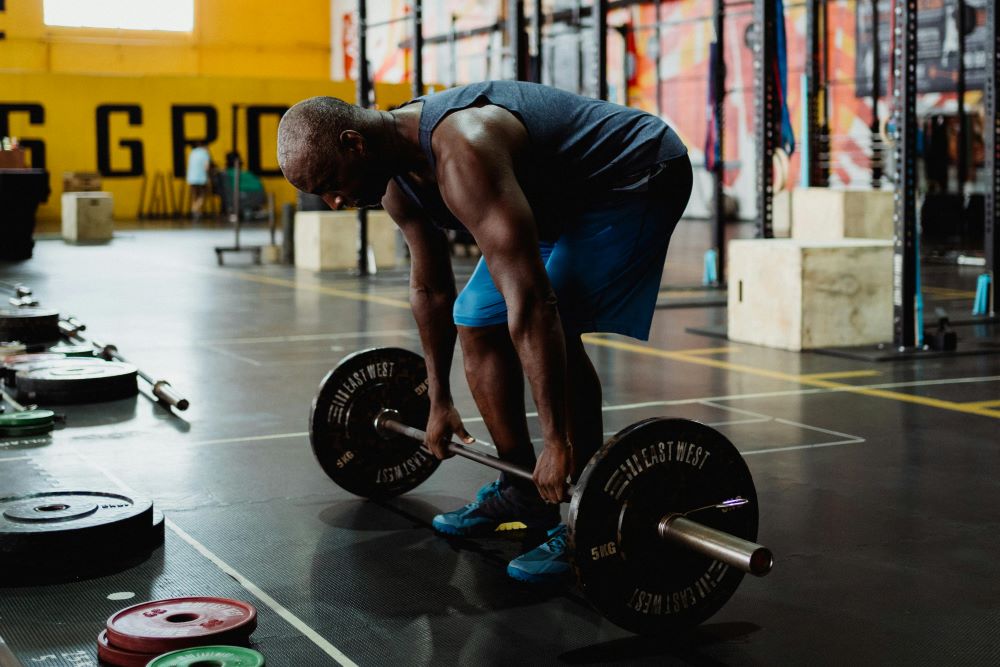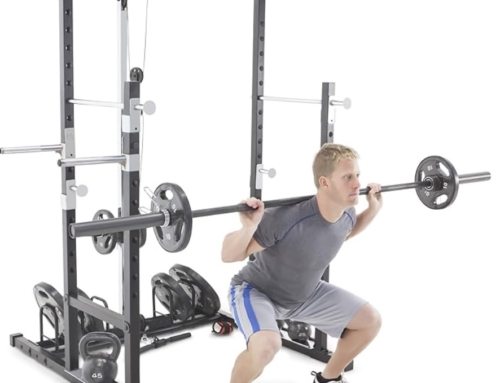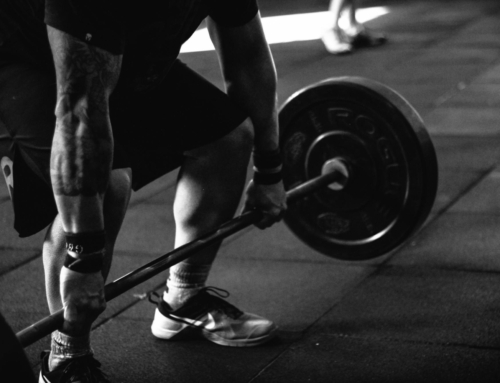Back just before the Covid pandemic really got started here in the U.S., my wife and I purchased a small home with a detached garage. Garages in this old neighborhood are actually a luxury.
I was stoked because I had not had a garage or basement gym in about ten years and I wanted to get back to working out.
Right after we moved in, I ordered up a power rack with lat pulldown, weight bench, and a 300 pound Olympic weight set. I already had my Bowflex Adjustable Dumbbell set.
On a weekend afternoon shortly thereafter, I put together the power rack. It took a few hours since I am mechanically challenged, so I knew I wasn’t going to work out that day.
However, just for the hell of it, I put two 45-pound plates on the bar and thought I’d bang out a few reps of bench press. 135 pounds used to be my warm-up weight before I would work at higher weights, so I didn’t expect too much difficulty.
I banged out a measly four reps.
(Hey, before you read further, I wanted to let you know about my Master Athlete program. So, after you finish this article, be sure to check it out here.)
While I had not had a full complement of gym equipment for a number of years, I at least worked out a bit, particularly with the P90X program.
Apparently, that didn’t translate into much lasting strength.
So, I jumped back into an old muscle building routine I had learned years earlier that focused on pyramid sets, with a few supersets mixed in.
The issue with that type of training is that it can leave you sore as hell for a few days. However, that is what I thought I needed to feel in order to build muscle.
After a few months of working out with this program, I realized I wasn’t getting much stronger either.
Over time, I realized I wasn’t making the progress that I wanted.
And then I discovered Starting Strength through a book called The Barbell Prescription.
After a number of starts and stops with the program, I gained an understanding of how effective that program is for building muscle after 50.
How to build muscle after 50
 In spite of a lot of the information out there, the best way to build muscle after 50 is through barbell training with heavy weight.
In spite of a lot of the information out there, the best way to build muscle after 50 is through barbell training with heavy weight.
And you only need five basic exercises… the squat, deadlift, bench press, overhead press and variations of the pullup (lat pulldowns if you can’t do a pullup).
These are all compound movements involving natural human movement patterns, multiple joints, and multiple muscle groups.
When trained consistently, and by slowly adding weight to the bar, these exercises combine to signal the body to adapt by building muscle, strengthen connective tissue and increase bone density.
The beauty of training this way is the simplicity.
And, because you are not training in higher rep ranges with multiple exercises, you don’t get nearly as sore.
Why many people over 50 don’t train this way
Most people over 50 are afraid to train this way, because personal trainers, doctors and physical therapists tell them not to.
They are told that lifting heavy weight will expose them to a higher risk of injury.
As a result, we are told we need to do two to three exercises per body part and focus on lighter weight and higher reps.
We are also told that we need to do 10 to 20 sets per body part per week to build muscle.
Who has time for all that?
However, that stuff sells because most people buy into the idea that a complex training program must be more effective at building muscle.
News flash… complexity does not equate to effectiveness.
Think about this… what could be safer than training natural human movement patterns loaded with weight?
This is why at the beginning stages of a proper strength training program, we do actually train with lighter weight.
This allows the trainee time to learn how to execute the movement patterns before the weight on the bar gets heavy.
In the initial phases of what we refer to as the Novice Linear Progression (NLP), we start conservatively and add weight to the bar with each workout.
We train three days per week.
Initially, we train with this bi-weekly pattern…
Workout A Workout B
Barbell Squat Barbell Squat
Bench Press Overhead Press
Deadlift Deadlift
These workouts are alternated so that each of them is trained three times every two weeks. The typical schedule is Monday, Wednesday and Friday.
In week 1, you start with Workout A on Monday, followed by Workout B on Wednesday and then Workout A again on Friday.
The following week, you train Workout B on Monday and go from there.
After a few weeks, we swap out the deadlift with pullups or lat pulldowns every other workout.
Eventually, as the weight on the bar has increased, the workouts become more difficult, and that is where the body really starts to adapt.
While training this way consistently, with small adjustments along the way, it is possible to increase the weight on the bar substantially.
For example, if you start out deadlifting 135 pounds for a set of five reps in Week 1, you should literally be able to deadlift over 250 pounds for a set of five reps after twelve weeks of consistent training.
This does assume that 135 pounds was not your five-rep maximum when you started. It would be dumb to start at a weight that is so difficult.
Let’s move on to the second important step to building muscle after 50.
You have to eat to build muscle
 If you want your body to adapt to the training, you will need to eat.
If you want your body to adapt to the training, you will need to eat.
You will be unable to build muscle and increase your strength significantly if you are restricting your calories too much.
It is critical that you eat enough protein to build the muscle and consume enough carbs so you have the energy to get through your workouts.
While there is some argument about how much protein you need to build muscle, it is recommended that you eat at least .65 to .75 grams of protein per pound of bodyweight.
Many will argue that the target should be 1 gram per pound of bodyweight.
For many people, that will be a tall task, and supplementation with protein shakes and bars will be necessary.
If you are significantly overweight, your target level of protein intake will be reflective of your near term bodyweight goals.
For instance, if you are 300 pounds, and want to get down to 250 pounds in the next six months, you won’t want to eat 300 grams of protein, assuming you don’t have much muscle mass to begin with.
Getting your calorie intake and keeping track of your macros, particularly your protein, is a critical component to building muscle.
Rest is critical for building muscle after 50
The last component for building muscle after 50 is rest.
After a hard training session, your body needs time to recover. A good night’s sleep is critical.
While you can get away with staying up all hours of the night in your twenties, that simply won’t work later in life.
Therefore, if you are a workaholic with your job, you will need to figure out how to scale it back. Too much stress will also interfere with your strength training.
We also don’t want to overdo it on our non-strength training days.
While we want to be active, we don’t want to go out and run five miles either.
There is a noted interference effect that occurs when you implement too much cardio exercise into a fitness program if you want to build strength.
Similar to our strength training, the dosage of cardio exercise must be appropriate.
High intensity workouts under 30 minutes can be effective, as well as longer, very low intensity workouts (Zone 2 cardio).
Both will help in your conditioning, which results in a greater workload capacity while not adversely affecting your strength gains.
Final thoughts on the best way to build muscle after 50
The best way to build muscle begins with an appropriate strength training program.
Keep in mind that the program evolves over time, as the ability to increase strength becomes more difficult as you become stronger.
With that said, an appropriate strength training program incorporates natural human movement patterns along with the best tool for loading them with weight… the barbell.
Any program that does not focus on the four main compound lifts, the squat, the deadlift, the bench press, and the overhead press, is simply inferior.
In order to replace those exercises, you have to use multiple exercises.
Why?
 Because you can’t load other exercises with as much weight as these four exercises, as these exercises incorporate the most muscle mass.
Because you can’t load other exercises with as much weight as these four exercises, as these exercises incorporate the most muscle mass.
To build muscle, you must also eat. However, after the age of 50, you have to be more careful about how much you eat, and how much of what you eat.
It makes no sense to get your protein from a sub that is loaded with cheese and mayo. You’re simply adding too many calories from other sources.
Diet rich in lean protein, vegetables and carbs such as rice and potatoes will get you where you want to go.
Lastly, you’ve got to get appropriate rest. Seven to eight hours of good sleep every night is absolutely necessary to allow your body to adapt to the stresses of difficult barbell training.
You now have the general blueprint for how to build muscle after 50.
If you want a complete program that will get you strong and healthy, check out my Master Athlete program. This is a complete wellness program that incorporates strength training, conditioning and mobility training into one program.
Now, get to work!
Discover more from Scott Allan Cole
Subscribe to get the latest posts sent to your email.








Leave A Comment